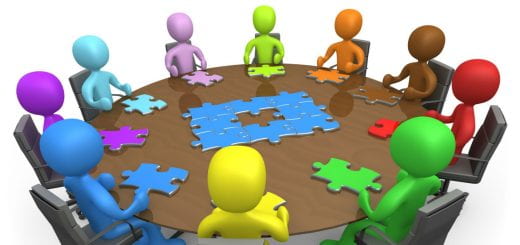Do Masks Mask Communication?
By Sarah Kegley, International TA Program Manager
One of the stranger parts of pandemic life involves one of the most important tools for mitigating it: the mask. We’re wearing masks to school, to work, to the grocery store, to go for a run or bike ride, and yes, to teach and to learn. And if you’re a rock-star president like Georgia Tech’s own Angel Cabrera, you wear a mask even while giving the President’s 2020 Institute Address!
What challenges await you and your students as you speak from behind a layer of cloth? What can you do to enhance this masked classroom communication?
The Research
Research from the fields of audiology, linguistics, and communication has identified challenges from the use of masks in communicative contexts. However, much of the research shows that while masks do present obstacles to communication, in general, the mask does not interrupt communication altogether. Although masks cause some speech quality degradation, primarily related to sound being muffled by fabric, there are ways that we can mitigate the challenges of masked communication.
Here’s the good news: consider the telephone. In Communicating While Wearing a Mask, Ginessa Payne reminds us that studies by Dr. Dominic Watt find that even though the common telephone obscures not only the face but the entire body, as well as other speech signals, we have adapted to using it with few misunderstandings. (Now if we could only foolproof email and text messaging!)
Tips and Strategies
Both Communicating While Wearing a Mask and Effective Ways to Teach F2F with a Mask and Create Caring Classrooms by Jamie Landau offer tips for communicating, humanizing, and even de-medicalizing the masked context. These tips are summarized below.
- Linguistic compensation strategies refer to the words & language we use.
- Because our mask touches our lips, we tend to reduce our motions, and “speak smaller.” Move your mouth! It’s OK to allow the mask to move with your lips—it’s only bothering you.
- Repeat phrases and paraphrase often.
- Use common everyday vocabulary in place of, or along with, jargon.
- It’s not what you say, but how you say it. Paralinguistic compensation strategies include the tone & intonation that show our attitudes & emotions. (Morley, 2001)
- Avoid relying on tone and intonation alone. Use words instead.
- For example, avoid:
- “Let’s begin chapter 5!” (using an enthusiastic tone)
- Instead, use words to explicitly state your enthusiasm:
- “Let’s begin chapter 5. I’m excited about this new topic!”
- For example, avoid:
- Similarly, sarcasm and humor are hard to read without paralinguistic effects.
- Avoid sarcasm
- Add language to explain humor. Again, be explicit. If it helps, add an emoji card that you can hold up, much like a TV show holds up the “applause” sign.
- Slow your rate of speech.
- Turn up the volume, but without shouting, because shouting can convey an emotion!
- Pause between phrases or thought groups, and chunk information.
- Emphasize and repeat key words and phrases.
- Use rhetorical strategies like sequencing, adding comprehension checks, and turn-taking.
- Invite questions more often, and be patient with student input!
- Extra-linguistic compensation strategies include nonverbal, facial expressions, posture, eye contact, hand movements, and gestures. (Morley, 2001)
- Make eye contact before speaking, and stay in a position that faces the audience, even if this means less walking around than you are used to. Use names when possible.
- Add gestures that get students’ attention, such as a clap or a bell. Create routines with these gestures or sounds.
- If possible, reduce background noise.
- Use positive body language. This means less often putting ‘hands on hips’, and more often having our hands clasped in front of us.
- Use gestures meaningfully (gesture left for point A, then right for comparison point B)
- Point to the relevant part of a visual aid and use descriptive visual language.
In related videos, Landau’s colleagues in theater and dance advise us to use laughter breaths (from the diaphragm) and create signs (some from American Sign Language) that help us organize and structure support for masked speech. Landau gives us more strategies to fight the fact that masks hide our emotions and “medicalize” the classroom.
- Create a welcome video –yes, with your own face and voice– for each course. This can help humanize yourself and your relationship to the class. It’s not too late to do this for a mid-semester check-in, or go ahead and begin one for Spring semester. A welcome video doesn’t have to be fancy; it just needs to be you.
- Create a temperature check- but instead of that clinical thermometer pointed at our foreheads these days, use emojis, or color cards, but go beyond a thumbs-up and thumbs-down approach. You can use this emotion measuring strategy to modify your teaching to those students present.
And remind yourself and your students that, over time, we will all become more proficient with communication while masking, just like we did with the telephone. Be patient.
References
Anderson, I., Valdosta State University. (2020, July 29). Speaking with a mask. [Video]. Youtube. https://www.youtube.com/watch?v=8vRIZK2E71s&feature=youtu.be
Goldin, A., Weinstein, B.E., & Shiman, N. (2020, April 1). How do medical masks degrade speech perception? Hearing Review. 2020; 27(5):8-9. https://www.hearingreview.com/hearing-loss/health-wellness/how-do-medical-masks-degrade-speech-reception
Landau, J. (2020, Aug 26). How to Teach F2F With a Mask and Create Caring Classrooms. Inside Higher Ed. https://www.insidehighered.com/advice/2020/08/26/effective-ways-teach-person-mask-opinion#.X3kZpMpeEL0.link
Llamas, C., Harrison, P., Donnelly, D., & Watt, D. (2008). Effects of different types of face coverings on speech acoustics and intelligibility. https://www.york.ac.uk/language/ypl/ypl2/09/YPL2-09-04-Llamas-Harrison-Donnelly-Watt.pdf
Morley, J. (2001). Aural comprehension instruction: Principles and practices. In M.Celce-Murcia (Ed.), Teaching English as a second or foreign language. (3rd ed., pp. 69-85).
Payne, G. L., Texas A&M University. (2020, Aug 16). Communicating while wearing a mask [Video]. Youtube. https://www.youtube.com/watch?v=rdPlpyaYDfM&feature=youtu.be




